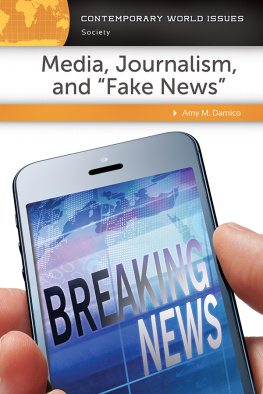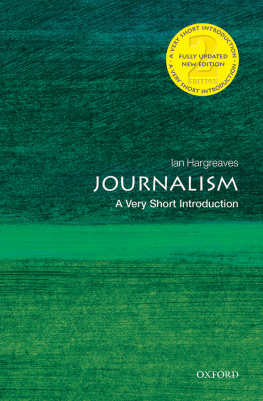
Understanding Broadcast Journalism
Understanding Broadcast Journalism presents an insightful exploration of broadcast journalism today; its characteristics, motivations, methods and paradigms. The authors balance discussions of industry practice with critical examinations of content, across television, radio and associated multiplatform journalism. They highlight key issues including ownership and shifting regulatory environments, the revolutionary role of user-generated content and digital convergence, and coverage of global issues by rolling news services.
Chapters include:
a brief history of broadcasting;
an overview of recent commercial challenges in the news industry and the impact on television news;
current trends in the running of local radio stations, with particular focus on the rise of hubbing;
the ethics of broadcast journalism;
the significance of international broadcasters including the BBC, CNN and Al Jazeera.
The book identifies how the dissemination of broadcast journalism is evolving, whilst also arguing for the continued resilience of this industry now and in the future, making the case that journalistic storytelling remains at its most effective in broadcast environments. Professional journalists and students of media studies and journalism will find this a timely and thought-provoking intervention, which will help to inform their professional practice and research.
Stephen Jukes is Professor of Journalism at Bournemouth University, UK. His research focuses on objectivity and emotion in news with an emphasis on affect, trauma and conflict. A former foreign correspondent and Head of News at Reuters, he has edited a series of books on the Middle East and written extensively on journalism and trauma.
Katy McDonald is Director of Excellence in Learning and Teaching for the School of Arts and Cultures at Newcastle University, UK. A former broadcast journalist, her research interests include the effect on journalists of technological, financial and cultural changes in radio newsroom practices. She has published on newsroom hubbing in UK commercial radio, and mediatisation.
Guy Starkey is Professor and Associate Dean Global Engagement at Bournemouth University, UK. His research interests include radio and journalism practices, institutions and technologies. A radio producer and presenter, his publications include Radio Journalism (2009, with Andrew Crisell) and Radio in Context (2013).
Understanding Broadcast Journalism
Stephen Jukes, Katy McDonald and Guy Starkey
First published 2018
by Routledge
2 Park Square, Milton Park, Abingdon, Oxon OX14 4RN
and by Routledge
711 Third Avenue, New York, NY 10017
Routledge is an imprint of the Taylor & Francis Group, an informa business
2018 Stephen Jukes, Katy McDonald and Guy Starkey
The right of Stephen Jukes, Katy McDonald and Guy Starkey to be identified as authors of this work has been asserted by them in accordance with sections 77 and 78 of the Copyright, Designs and Patents Act 1988.
All rights reserved. No part of this book may be reprinted or reproduced or utilised in any form or by any electronic, mechanical, or other means, now known or hereafter invented, including photocopying and recording, or in any information storage or retrieval system, without permission in writing from the publishers.
Trademark notice: Product or corporate names may be trademarks or registered trademarks, and are used only for identification and explanation without intent to infringe.
British Library Cataloguing-in-Publication Data
A catalogue record for this book is available from the British Library
Library of Congress Cataloging-in-Publication Data
A catalog record for this title has been requested
ISBN: 9781138240995 (hbk)
ISBN: 9781138241008 (pbk)
ISBN: 9781315281650 (ebk)
Typeset in Sabon
by Out of House Publishing
Contents
A scholarly work on the subject of broadcast journalism, especially one which is to be committed to paper, faces a number of challenges. The most obvious one is that of currency. Writing about a field which can change very rapidly, and publishing the work in a medium which is notorious for its lengthy production processes the academic book is almost to invite the subject matter to transform itself unrecognisably overnight. When writing the introduction to a previous book, Local Radio, Going Global, one of the authors noted the interesting coincidence of the word global in the title also being the brand name of the UKs largest commercial radio group, Global Radio (Starkey, 2015: xi). It may be, he warned, that because change in the media industries can happen very fast, the group of radio stations might have rebranded itself with another name or been bought by another, even larger business entity, perhaps long before the print edition of the book was delivered by the printers. In fact, that didnt happen, and at the time of writing this new book, some seven years later, that same group remains the most significant on the UK commercial radio landscape. Despite a rather idiosyncratic decision to call its parent company This Is Global Limited, at the time of writing, the name Global is even heard during every news bulletin broadcast by the radio stations it operates.
Such fortunate happenstance cannot, however, always be relied upon, and the question remains: how to ensure such a book as this remains current for long enough to justify the investment in it by the authors, the publisher and indeed the reader? In fact, the answer is simple. A name change is purely cosmetic, while the underlying principles of broadcast journalism have remained unchanged for decades. Even the introduction of new technology and the development of new platforms for the dissemination of journalistic content a word to which we will return many times in this book have done little to change the basic principles of storytelling through broadcasting. A second author worked for several years in a commercial radio newsroom, compiling and editing news bulletins in peak time, learning to cope with changing circumstances and consistently meeting the regular on-air deadlines that so obviously distinguish the broadcast variant from other forms of journalism. Even though since then the emphasis on putting content online and making it accessible on demand via mobile devices has grown considerably, as we shall argue, such modern methods of dissemination remain ancillary to the main activity of broadcasting in the broadcast journalism newsroom.
In terms of television, another advance in recent years has been the development of internationalised rolling news services such as RT, CGTN and Al Jazeera, which broadcast across national boundaries from Russia, China and Qatar respectively. Our third author worked around the world as a foreign correspondent and editor for the international news agency Reuters and gained a breadth of experience in presenting news stories using words and moving images in ways that would be instantly accessible to audiences in different national markets. These were often major breaking news stories with the potential to resonate globally in terms of both impact and influence. Yet these stories also called for explanation and contextualisation to make them understandable thousands of miles away from their epicentres. In short, each of the authors of this book has worked in and researched different areas of broadcast news journalism, focusing on our own specialisms, as the craft has continued to evolve since we began teaching it instead of practising it. This has, in turn, allowed us to develop an objectivity and a comprehensiveness in our approach to the subject that would not be possible if we were each still caught up in the minutiae of daily work routines in one medium or another. Of course, our research is not only academic but includes ongoing engagement in the profession, along with learning to use emerging software and innovative platforms, as well as networking with and interviewing current practitioners about their work.








